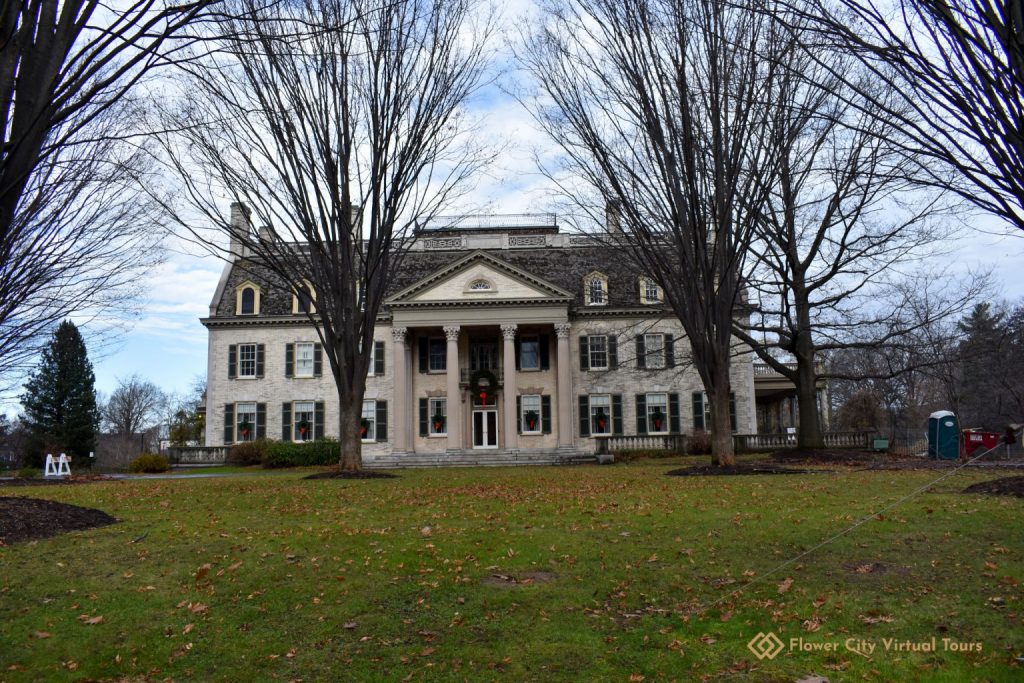George Eastman Museum

The George Eastman Museum Mansion and Gardens Eastman Museum provide a glimpse into the life of one of the greatest American innovators and entertainers in the first decades of the twentieth century. George Eastman was an entrepreneur, a philanthropist, and the pioneer of popular photography and motion picture film.
Located: 900 East Avenue Rochester NY 14607
Contact: (585) 327-4800 or Homepage | George Eastman Museum.
Hours: Sunday: 11:00am-5:00pm Monday: Closed Tuesday-Saturday 10:00am-5:00pm
The Dryden Theatre:
The George Eastman Museum also features the Dryden Theatre. The 500-seat presents film screenings every day of the week.
Ticket prices are: General $10, Museum Members $7, Students and Children: $5, SNAP or EBT cardholders and their families: Free, Active-duty Military and their families: Free
You can find a Printable Calendar of all the Film Screenings available on the website. Showtimes are generally 7:30 pm. Patrons must show proof of vaccination and wear masks.
For interesting facts on the Projection, Nitrate Film, Sound and History of the Dryden Theater see the website:
George Eastman Museum Facts:
The 8.5-acre property was purchased in 1902.
Architect J. Foster Warner based the design of the mansion on the Root House in Buffalo.
The Colonial Revival mansion was built between 1902-1905.
The 35,000-sqft., 50-room residence is made of reinforced concrete.
Served as George Eastman’s primary residence until his death in 1932.
Explore the historic mansion on your own or on a guided tour, offered daily.
Live music performances are offered in the mansion most Sunday afternoons.
George Eastman’s urban estate functioned as both a working farm and an elegant floral setting for entertaining.
The urban estate was complete with working farmland, formal gardens, greenhouses, stables, barns and pastures.
The total cost of the initial construction was $335,000 (around $9 million today).
Modern conveniences such as an electrical generator, an internal telephone system with 21 stations, a built-in vacuum cleaning system, a central clock network, an elevator, and a great Aeolian pipe organ.
The interior design was by William Rutherford Mead of the New York firm McKim, Mead & White which had worked on Andrew Carnegie’s house in New York and on the White House.
In 1919, the conservatory was enlarged. The architect, William G. Kaelber drew up plans to cut the house in two and move the rear section 9’4” to the North using hydraulic jacks on railroad ties with special wheels on tracts. The project cost $750,000 and took 3 months.
A fourteen-month restoration of the mansion was completed in January 1990.
Open Face features hand-crafted specialty items. It is open to the public and has limited seating.
The gardens welcome visitors May through September for daily guided tours, self-guided strolls, summertime concerts and special events.
Original plans, historic photographs, correspondence, and invoices were used by garden historians to reconstruct the original gardens and grounds.
The Schuyler C. Townson Terrace Garden is the oldest and most formal Italianate Terrace Garden on George Eastman’s estate. It was designed between 1902-1904 by Alling DeForest to complement the mansion and its principal rooms. There are 23 beds containing more than ninety varieties of plants.
The Library Garden is a modern adaptation of DeForest’s plan for Eastman’s cut-flower garden. Built on top of the underground, two-story vault containing the museum’s photography, technology and motion picture archives, it is actually a rooftop garden with a soil depth of barely two feet.
The Rock Garden and Grape Arbor: DeForest designed this informal garden rocky landscape, which functioned as a hidden picturesque destination for Eastman’s guests following a stroll through the property. In Eastman’s time, a network of paths and drives connected it to all the other gardens on the estate, as well as to the greenhouses, poultry yard, orchard and the stable.
Built-in 1917, The West Garden was designed by architect Claud Bragdon, who modeled it after an English walled garden designed by Sir Edward Lutyens and Gertrude Jekyll at Hestercombe House in Somerset, England. This garden has been altered many times over the years. Lastly, in 1983, the Rochester Garden Club sponsored a partial restoration of the garden and that rendition is what visitors enjoy today.
In Conclusion:
The Eastman Museum Mansion and Garden is a must-see for anyone who has an interest in history, architecture, photography, garden and interior design, or just a love of houses and gardens in general. Events are hosted throughout the year.

